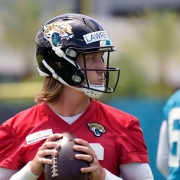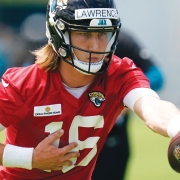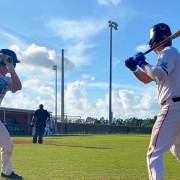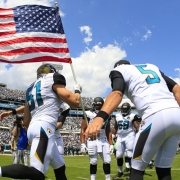To Rate A Quarterback
When the Jaguars took Trevor Lawrence with the first overall pick in the NFL Draft last April, he became the twenty-first quarterback taken with the top pick in the last three decades. Two of those twenty-one, Peyton Manning and Troy Aikman, are in the Hall of Fame. Only one other, Eli Manning has won a Super Bowl. Among the eighteen remaining, only two, Cam Newton and Drew Bledsoe ever got their team to the title game.
For some, the jury is still out as Lawrence will become the eighth active quarterback in the league who was a number one pick. Quarterbacks have been the top pick the last four years and six of the last seven. That position is always over-valued in the draft, but clearly the expectations are high. When a team spends the number one pick on that position, they hope it changes the fortunes of their franchise.
“Wins and losses in the long run the first year don’t matter,” said Hall of Fame personnel evaluator Bill Polian. A six-time NFL executive of the year, Polian this week said what you look for in that first year for your franchise quarterback is “progress.”
“Peyton still laughs about his rookie year,” Polian said of the 3-13 finish for the Colts in 1998. “He still holds the record for interceptions by a rookie (28).”
While every throw, every step, every play this week by Lawrence has been dissected and charted by fans and the media, Polian says it’s a broader view that will let you know if your quarterback is going to make it or not.
“Players improve week to week, not really day to day,” the Hall of Famer said of the evaluation process. “At the end of the week ‘is he progressing’ will be the question the coaches are asking each other. That’s important in camp and in the preseason games. It’s not necessarily what the fans see. It’s how he’s managing the game, the command of the huddle, the command of the offense. And then being able to put it into practice when the lights go on.”
Quarterbacks who have played in the league say the same thing: there will be ups and downs for a rookie because it’s a different game. Faster, more complex, and for the first time, you see defensive players better than any you’ve played against.
“Trevor will have great practices and games and bad practices and games,” said Matt Robinson, a ninth-round pick for the New York Jets out of Georgia. “You need to get past the bad ones to have more great ones.”
And how you get past those bad days and on to the good ones is completely different in pro football according to Steve Pisarkiewicz, a first round pick by the Cardinals after a college career at Missouri.
“It’s a different game,” ‘Sark’ said about the transition to the pro game. “You spend the whole preseason doing the installs and learning the playbook. You might practice a play four times in one practice in college. In pro football they don’t have that kind of time, especially not now with the practice restrictions. They’ll practice a play once in the pros and talk about it in the film room. That’s where you have to adjust.”
Getting support from the coaching staff and your teammates is important for a rookie quarterback to develop. Some get it and some don’t. David Carr was so beat up after his rookie year he was never the same.
“That’s so important,” Polian stressed regarding supporting a rookie quarterback. “Late in Peyton’s rookie year we were in Baltimore in a tight game late. We have the ball and Peyton has an audible route to Marvin and he’s open in the end zone. And either Marvin ran the wrong route or Peyton threw the wrong route, but it didn’t work, and we lost. I told them after (Head Coach) Jim Mora talked to them and said, ‘this will never happen again. I’ve seen you guys’ work. Don’t worry, this won’t happen again. And it didn’t.”
Having played at the highest level and competed for championships during his college career at Clemson, Trevor Lawrence comes into the pro game one step ahead of most rookie quarterbacks making the transition to the next level. But there are things he’ll have to learn.
“Your pre-snap reads are everything,” Pisarkiewicz explained. “You don’t know that as a rookie. In college, you don’t see how teams disguise their coverages like they do in the pros. They tighten up the seams for throws in the pro game.”
Nobody doubts Lawrence’s physical skills. Polian says he trusts Clemson Head Coach Dabo Sweeney ‘100%’ when it comes to evaluating his players and “He thinks he’s something,” Polian added.
Robinson thinks it’s a little deeper than that when a rookie quarterback sticks his head into the huddle for the first time when the lights are on. If the other ten guys on the field know he knows more about the offense than they do, they’ll trust him.
“The team will follow how Trevor treats the players around him, how much he’s willing to work, and how much respect he gains from his teammates. Robinson said. “If they’re willing to fight for him, he can be the difference between six wins and nine wins as soon as this season.”
What do you look for if you’re not there in every meeting, every film session and every offensive and quarterback meeting? As they like to say in the NFL, is the arrow pointing up?
“I’ll look for calm mechanics,” Pisarkiewicz said. “Footwork, composure. In the NFL he’ll have to operate from the pocket a lot. I’ll look for his poise in the pocket.”
“There’s no magic right now for Trevor,” Robinson added. “He’s a great player. He’s had great success. At this level, it’s about how he understands the game plan. What they’re doing in the first quarter to set things up for the fourth quarter. What the offensive coordinator is trying to do and how it changes week to week, that’s where the magic will happen.”
All things point to Lawrence being under center in the Jaguars first game against Houston. Other quarterbacks, like Patrick Mahomes and Aaron Rodgers, sat for at least their rookie year. Polian said that’s always beneficial, but in the case of a generational player like Lawrence, similar to Manning, the combination of his physical talent and his emotional makeup almost demands you put him in the game.
“For the first time in your life you’re going to get slings and arrows and you’re going to play against guys who are as good as you,” he explained. “When you’re in college, you’re better than everybody. He has to have played a lot of football and played in a program that has similar concepts to the pro game. I’ll tell you this, It’s not for everybody.”
If Polian was writing a scouting report on Lawrence, he said it would go something like this:
“Big arm, great athlete with great poise. Very football savvy. His football IQ is high. He’s a leader who played at the highest level. There’s nothing that would lead you to believe that he couldn’t succeed.”
And he added, “I don’t know what his emotional IQ is, but I know the Jaguars do. If you’re going to be great in the NFL, you’ve got to make the sacrifices. Unless you’re fully engaged, you’re not going to make it. The league is too tough.”
And this year might not provide the answers. Charting quarterbacks in practice might be a good hobby, but as we’ve seen with previous Jaguars quarterbacks, when the lights go on inside the stadium, that can be something totally different.
At the end of the season is progress being made? Is the arrow pointing up?
“Is your quarterback getting more efficient? Are you seeing growth?” Polian concluded. “You look at the careers of all of the greats, the arrow is up at the end of the first year they play. And that’s when they make the biggest jump, after the first year.”
And some of it you can only see happen when it counts.
” As the quarterback, if you empower those other guys on offense, they’ll get the job done,” Robinson explained. “It only happens when the quarterback is on the field in the heat of the moment.”





